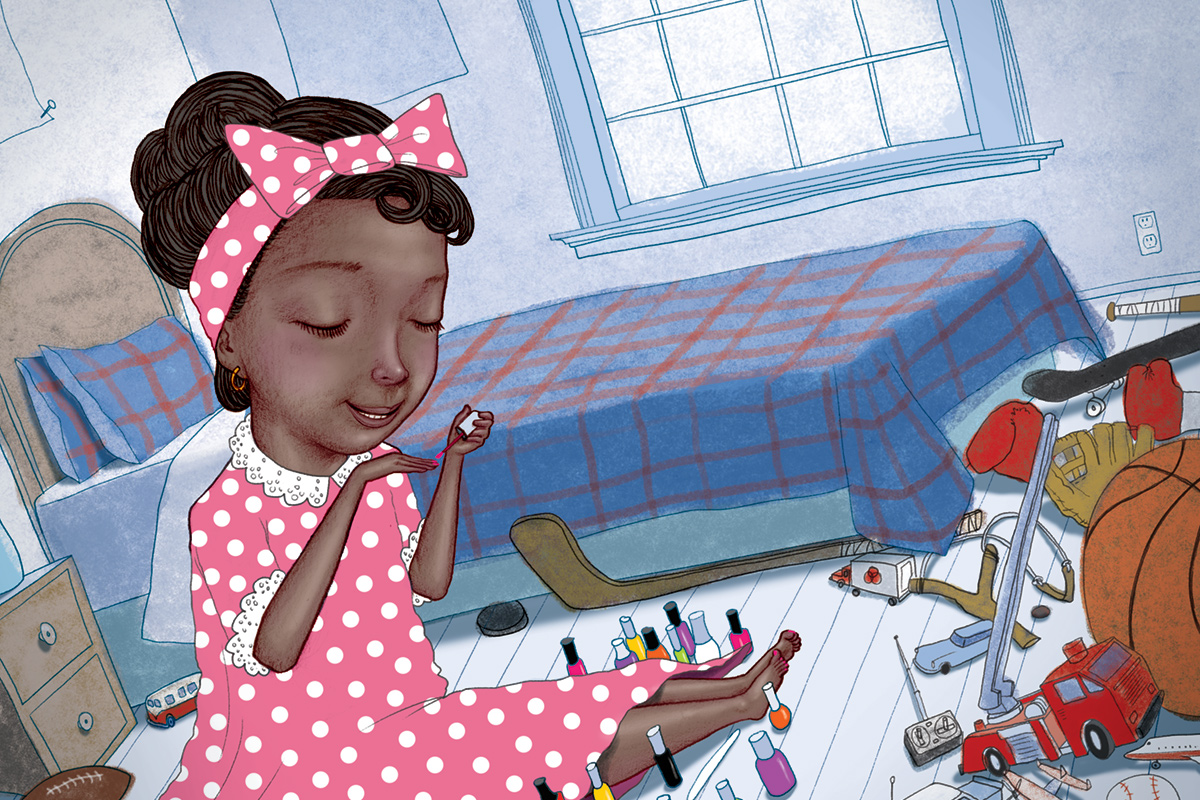Coda
Raising a Tomgirl

I am tying my toddler daughter’s shoes even after she insisted that she do it “all by herself” when she looks down at my hands, touches my slightly dirty nails, and says, “You need your nails painted.”
I feel like I’ve failed a final exam after studying diligently for an entire semester. It’s not the nail test I care about; it’s the raising-a-tomboy-who-defies-all-gender-policing test I’ve been studying for since the ultrasound technician said, “There’s our little lady!”
How does she know that? I thought later as I stalked the layette section of a department store, slightly dehydrated and drunk on the revelation that my baby shower would be full of pink. How does she know that her sex will determine her gender identity? Why pink? Why lace? Why ribbons? Why all of these embroidered hearts? The questions, the lights, the incessant elevator music, and the dehydration all made me a little dizzy.
The numbers were even more dizzying. My daughter would be born into a set of numbers that told a story about her life before she had a chance to live it. Black and female have been the topics of headline-worthy statistics since Patrick Moynihan made it his business to “study” the black family. When the topic is black girls and women, the words “research shows” are indicators that I should hold my breath and brace myself for more bad news.
I began to look for good news in my own literary research and found it in the strange autonomy of black girlhood. In the liminal space that Toni Morrison called “not maleness, not whiteness, not ladyhood, not anything,” the black girl subject of late-twentieth-century literature created herself. In 1970, Morrison’s Claudia MacTeer disassembled a baby doll to see what all the fuss over blue eyes was about. In 1972, Toni Cade Bambara’s Hazel observed that girls didn’t smile at each other “cause maybe we too busy being flowers or fairies or strawberries instead of something honest and worthy of respect . . . you know . . . like being people.” In 1973, Morrison’s Sula rejected so many societal constraints that she found herself on the margins of a community, foreign even to her best friend but entirely true to herself. In 1982, Alice Walker’s Shug Avery imagined herself connected to the divine through nature and sexuality, rejecting her preacher father’s piety and angry god.
The words spoken by these characters were scriptures for me, a first-time mother who experienced the world as a dangerous place. These characters gave me hope that it was possible to thrive, not just exist, within the confines of race, class, and gender marginalization. The girls and women in these novels bent a world to fit their understanding of it; they had the audacity to require those around them to follow suit. They defied numbers, healed their own wounds, and saved themselves.
To save my own daughter from the stories statistics tell, I bought pants—lots of them. Many of the spunky girl characters I’d grown to love were tomboys who not only rejected the “girly” behavior their mothers tried to enforce, but scoffed at them. I bought trucks and train tracks and shopped in the boys’ section of the toy store. I watched Thomas, Elmo, and Caillou. I avoided Barbie like the plague. “Tell me why she sexis’, Mommy! Tell me!” my daughter screamed once as I accidentally rolled through an aisle that looked as if it had been drenched in Pepto Bismol.
But now, after all of the work I’ve done, all of the Disney princess merchandise I’ve refused to buy, all of the literary tomboy characters I’ve elevated to prophet status, I am tying the shoe of a little girl who insists on skirts, nail polish, and beads at the ends of her braids. And she is gender-policing me.
She wedges her tiny finger underneath my nail, trying to affect the rush cleaning job I do on the nights when she says, “Mommy, paint my nails.” I think of what we do when I comply, the goofy stories we tell, the way I pretend to breathe dragon fire when I’m helping her dry her new polish. I think of the way she giggles when she looks at her nails—the way she thrives in these moments that are all about her. And now that she is cleaning my own nails, I realize that she is giving me her time. If I’d let her near a bottle of polish again (a miracle saved my couch after her last attempt), she’d likely paint my nails for me. Maybe “you need your nails painted” is toddler-speak for “Mommy, I see you. You’re tired sometimes. You rush. You don’t take time to sparkle. Let me help.”
I should be as observant as my daughter. Then I would notice her toddler fierceness—her insistence on doing things all by herself—a resolve that rivals any of the characters I most revere. After all, it’s not just the gender performances that made my favorite characters radical. It’s the fact that they trusted their own choices; they didn’t seek permission to glory in their own bodies, which were always already marked by a nation’s unease.
In my lap is a girl who is learning to trust her own choices, and I am a mommy who is learning how to read the story she will write all by herself.
Asha French 14PhD is a freelance writer and an Emory doctoral candidate in the Department of English.
Email the Editor



